Workflow templates have become essential for any project. Whatever task your team is working on, you need a central tool to set up and visualize key components of the process, how they fit together, and the order in which to complete the tasks.
A workflow template gives you a solid base to map your business process from start to finish, making things a lot easier. We’ve created an easily customizable workflow template that you can quickly adapt to your business, with many useful features designed to make efficient workflows right away.
In this article, we’ll share the template, break down how to fill it out effectively, and explain how it should fit into your greater project or task management efforts.
What is a workflow template?
A workflow template is a project management tool that helps you create a visual representation of your workflow process — it outlines the steps and people involved in a process, so you can use it to benchmark and help your team become more efficient. It can take the form of a flow chart, an activity diagram, or a business process model and notation — BPMN. A workflow template illustrates the key steps of your project and how they fit together.
A workflow is a sequential series of activities that need to be completed in order to complete a particular task or goal. In essence, a workflow is how you plan to get work done. For example, the process of onboarding an employee is a crucial workflow.
Having a completed workflow template helps demonstrate to your stakeholders and your team exactly how you plan to get your project off the ground and completed. It serves as a blueprint for operations that anyone involved in the project can refer to at any point to clarify priorities and order of operations.
Why use a workflow template?
Here are four big reasons that a workflow template can be so beneficial during any project.
Helps with planning
Productivity starts with planning, and a comprehensive workflow template makes sure that you start your planning process on the right foot. If you know that your ideas fit together seamlessly but are still muddled in your head, then a workflow template helps you with the journey mapping process. This clarifies the order of operations for everyone involved.
Creates transparency
A workflow chart template leaves no room for guesswork by mapping out projects or processes. Your business process needs to be clear not only to you but to every team member and stakeholder as well. This way, everyone feels confident in the plan and can execute tasks in the correct order with the ability to refer back to it as needed.
Predicts bottlenecks
You cannot expect to complete a project in good time without first viewing the overall plan.
Getting the full view of a project will help project managers anticipate bottlenecks and obstacles before they happen — you can then assign more team members to problem areas and ensure progress isn’t delayed more than it needs to be.A clear-cut map of your project allows for both broad and detailed planning well ahead of time.
Facilitates delegation
As much as you might trust the plan as it lies in your head, you need a visual map to communicate and delegate ideas to the right team member. A workflow template does half the work for you by establishing which steps go where. You can refer to your workflow template to help your team members understand what tasks they’re responsible for and how their work fits into the bigger scheme of things.
What are some examples of a workflow template?
You can create a workflow chart to map out projects in any industry. Let’s look at some examples of workflow templates in practice.
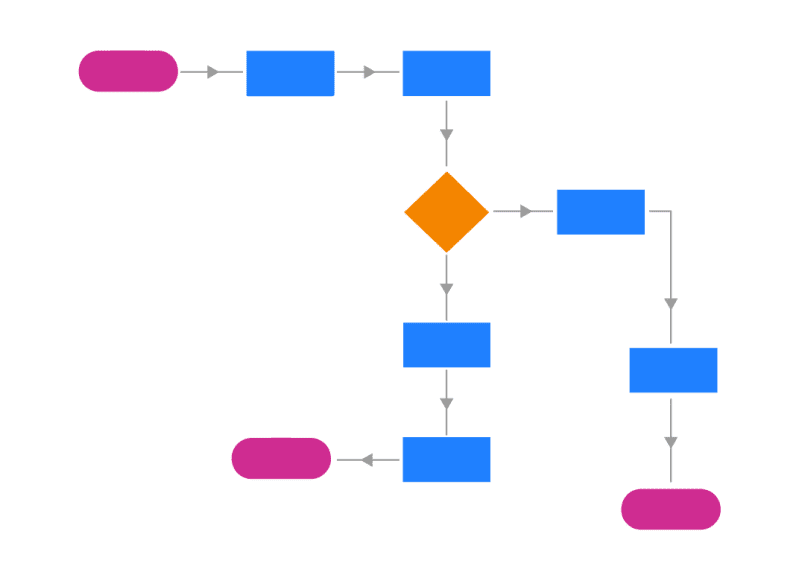
Recruitment workflow template
This workflow template breaks down the recruitment process into stages and shows how each stage follows after the other. Visually representing the hiring process provides clarity for hiring managers and HR. By referring to this process map template, everyone is on the same page about what steps need to be taken before offering a job to a potential employee.

Using a recruitment chart template like this one helps to make sure that no steps in the hiring process are missed. Each potential candidate is properly vetted and assessed according to certain criteria. This helps companies ensure they are hiring employees that fit the company culture and are fully qualified for the job.
Check out the recruitment process template if you want a more granular template that can help you manage the applicants throughout the entire pipeline.
Workflow template for B2B prospecting
This workflow template is a detailed road map for B2B sales professionals to follow during prospecting. It breaks down the prospecting process into steps, and within each step are relevant tasks. Each step is connected by outcomes, depending on what happened in the previous step. The structured steps and follow-ups prevent sales reps from spending too much time on one prospect.
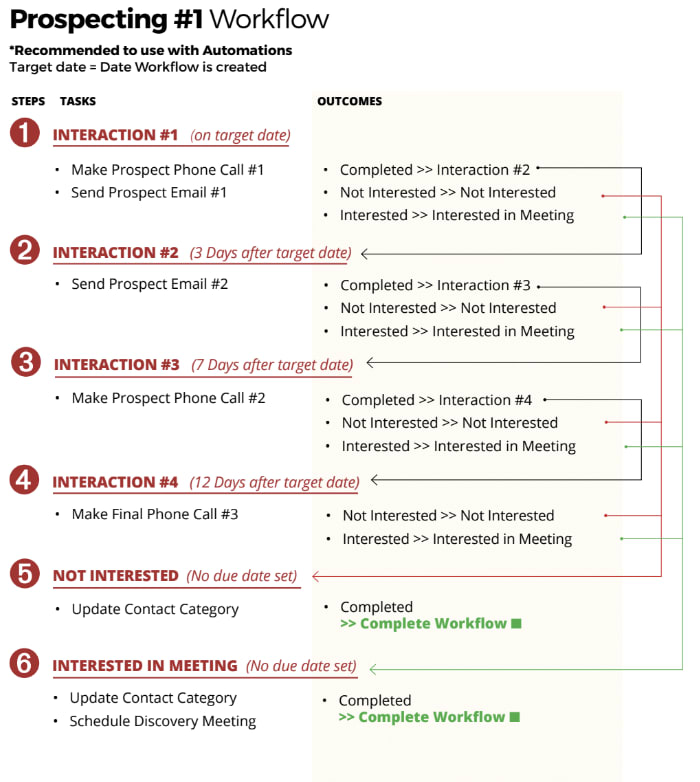
For example, if a sales rep sends an email in step one and the prospect isn’t immediately interested, they know to jump to task five and update the “contact category.” The workflow is then complete. But if the sales rep doesn’t receive any feedback after their email, they know to move on to step two. They must now send a follow-up email three days after the first interaction.
monday.com’s workflow template
It can be daunting to design your own workflow chart from scratch. That’s why we’ve put together a user-friendly workflow template to help get you started.
You can, for example, break down every stage of the project management planning workflow into different stages and tasks, with deadlines, color-coded priorities, budgets, timelines, and more.
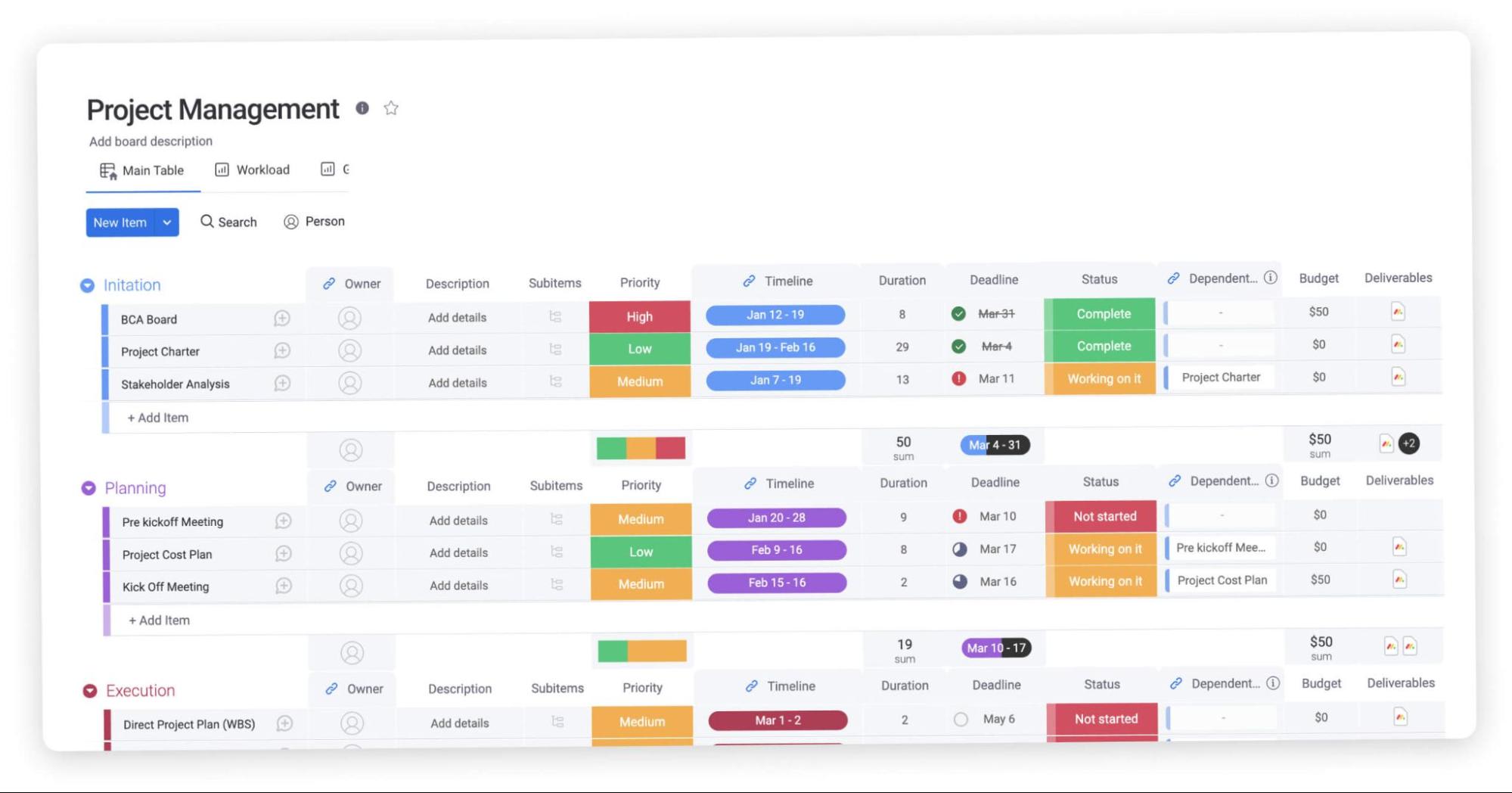
You can also visualize the workflow with the timeline view to see when what should happen.
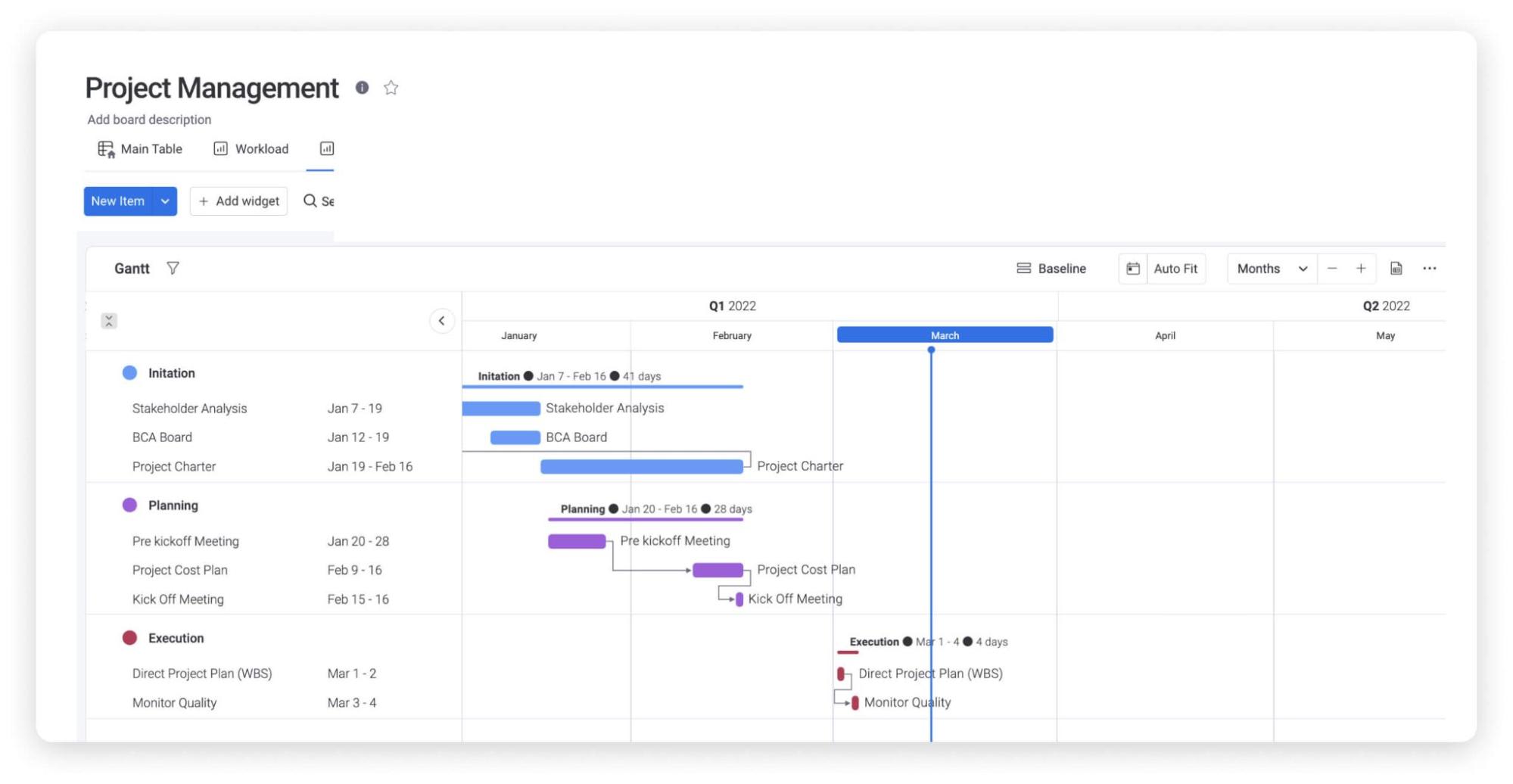
It can act as a benchmark to compare your team’s performance against in real-time.
monday.com’s main strength is interactive, collaborative visualization tools that combine your team’s efforts into one centralized location. Here’s what our platform brings to the table:
Assign as many owners as you need
It’s no use having a beautifully designed workflow that isn’t put into practice. Workflows are there to help break down work and get tasks done. And that requires task ownership and delegation.
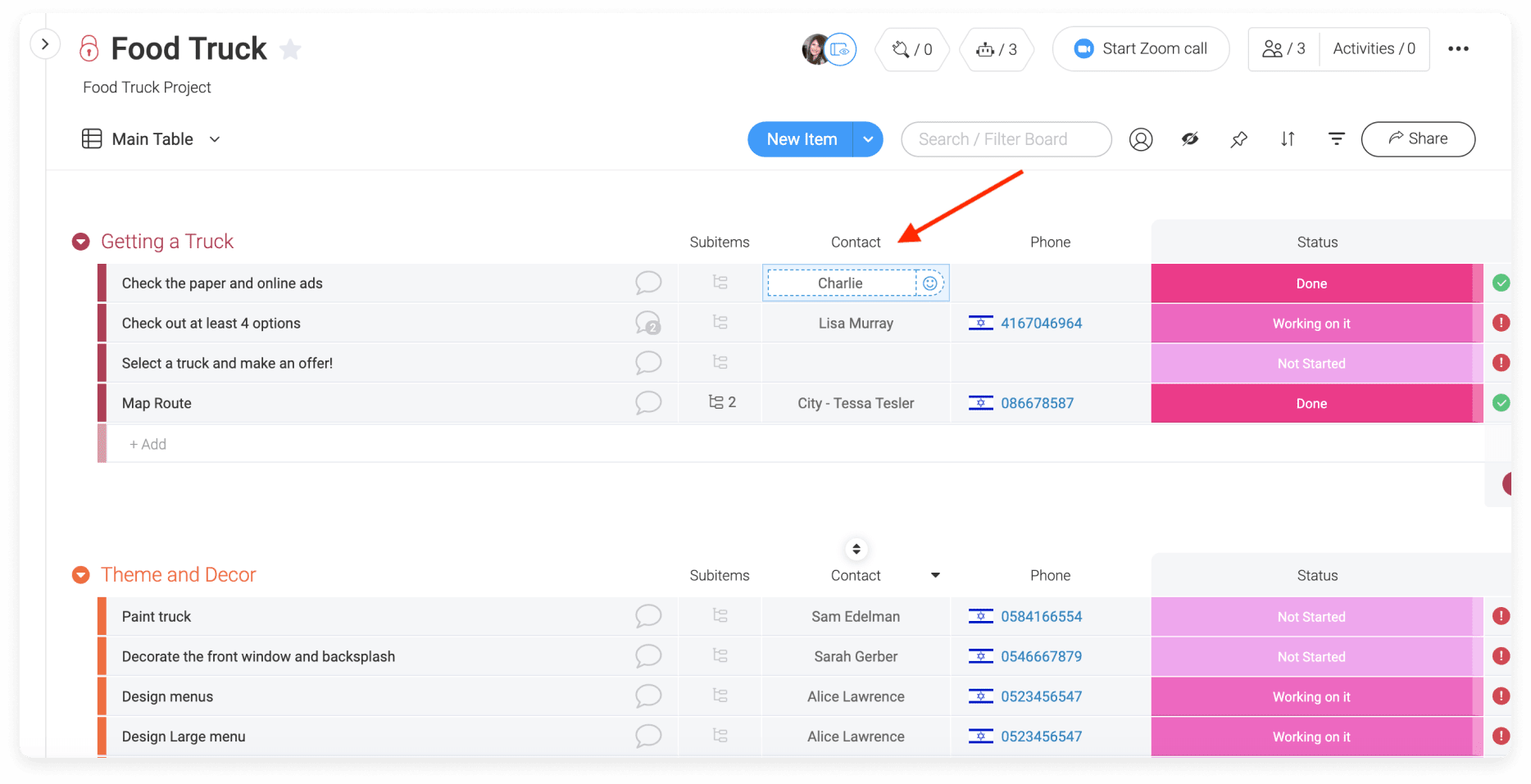
Instead of constantly referring to a hard copy of your workflow to see who’s in charge of what, your team can log into monday.com and check their tasks. You can easily assign tasks to the relevant person, people, or team with the click of a button.
They’ll automatically receive a notification, so they know their responsibilities in the project. If any team member needs a reminder, you can set up automated reminders that nudge them back on track.
Easily update your workflows
Workflows aren’t set in stone. Productive teams are flexible and always looking for more efficient work processes. This means having to continuously update your workflow, while keeping every team member on the same page.
monday.com’s workflow template means you don’t have to reinvent the wheel every time your process changes. Our drag and drop interface makes it easy to tweak your workflow on the go and still keep everyone in the loop.
Having your workflow easily accessible on one platform also makes workflow analysis easier. Your entire team can understand where there’s room for improvement and make suggestions — all in one consolidated place.
Seamless integration
Our workflow template easily integrates with other project management and communication tools to seamlessly transition into using monday.com. You won’t have to change any part of your existing process. Our templates can be integrated with services like Outlook, MS Teams, Slack, Zoom, Google Drive, LinkedIn, and other widely used software. This will minimize the time and energy needed to implement new working structures.
With our robust, customizable, and centralized workflow template, you can safely kiss confusion and miscommunication goodbye. It’s never been easier to complete a project.
Related templates
Project management template
Keep track of your deadlines, project phases, stakeholders, timelines, and tasks, all in one place. Organize your tasks based on priority, assign tasks to team members, and collaborate online with monday.com’s Single Project Template.
Software development template
A team of developers needs to be in sync with project needs, tester feedback, and task progress at all times. With our Software Development Template, you can easily create, track, and categorize tasks as they arise. Identify common problems, monitor your progress, and develop a roadmap with ease.
Business process template
The Process Management Template helps you break down and manage vital processes like invoicing, employee onboarding, etc. From company goals and business plans to task management and trial runs, this template does it all.
FAQs about workflow template
How do I create a workflow template?
Creating a workflow template for your business is tricky, which is why monday.com has done half your work for you. Our workflow template includes common columns and sections, but is completely customizable, so you can easily make the template your own. All you need to do is outline your unique business processes.
How do I create a workflow?
The best way to create a successful workflow is to determine your beginning and endpoints. From there, it becomes easier to visualize where each phase of the workflow will fall, and how one leads to another. monday.com’s template makes the whole journey mapping process easier.
What are the three basic components of a workflow?
Most workflows consist of input, transformation, and output. In other words, what do you put into the project, how does it change, and what emerges on the other side?
What are the three types of workflow?
- A sequential workflow is a linear chart that progresses from one step to the next with no regression in planning.
- A state machine workflow is non-linear, meaning it can regress back to previous phases depending on the outcome of a certain step.
- A rules-driven workflow operates on a true or false model. In other words, you may have two potential outcomes for a certain step. There is a preconceived set of subsequent steps for each outcome.


